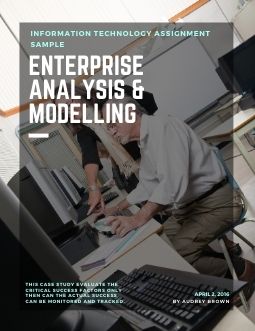
You can download the sample Information Technology essay on Enterprise Analysis & Modelling with the following question for free at the end of this page. For further assistance in Information Technology Assignment help, please check our offerings in Information Technology assignment solutions. Our subject-matter experts provide online assignment help to Information Technology students from across the world and deliver plagiarism free solution with free Turnitin report with every solution.
(AssignmentEssayHelp does not recommend anyone to use this sample as their own work.)
Information Technology Assignment Question
The assignment item in this course will be assessed according to the degree to which you demonstrate your capability in the following:
Selection of articles and books
- a wide and appropriate reading in the topic area(i.e. you have not just referred to the textbooks and resource materials).
- At least 12 reference sources
Content and argument
- An understanding of the material and concepts
- critical consideration of the main issues involved
- an ability to construct logical, rational arguments to support your propositions, assertions or opinions
- a capacity to critically evaluate the topic material.
Communication, presentation and referencing skills
- an ability to answer the assignment requirements in a clear ,concise and comprehensive manner
- a capacity to completely answer the assignment topic within the word limits set.
- Presentation skills, including correct grammar, spelling and punctuation.
- Submission of work in the appropriate format.
Information Technology Assignment Solution on Enterprise Analysis & Modelling
Executive Summary:
DSW as a growing firm decides to have SAR ERP implemented in a Big-Bang approach. This approach is quite different from the parallel approach where both old and new systems work in parallel until a level of comfort and satisfaction is obtained. Opting for a Big-bang way carries its own risks. DSW takes some important steps in this regard, starting from devising a strategy at the Organizational level to monitor the change well. Properly time-lined methods for enterprise analysis, proper team formation to resolve conflicts well in time, good initiatives to foster a feeling of need-to-change in the organization by gaining up worker confidence. DSW takes some important decisions with regard to the level of customization which has its own positive as well as negative impacts in the end. In the end, with some glitches, the project gets completed well before time and within budget.
Introduction:
ERP or Enterprise Resource planning is an important tool to integrate business and management practices with the latest technology. Managing data from a single point reduces the problems of synchronization and reduces the overall complexity of an enterprise. A good ERP exactly replicates the functional needs of the organization (Fiona Fui-Hoon Nah, 2006). However, when going for an ERP implementation it is highly important to evaluate the critical success factors only then can the actual success can be monitored and tracked…
Read more in the complete solution PDF document at the end of this page.
Organizational strategy
When opting for a robust ERP implementation, the organizational strategy plays a very crucial role. Each industry has its own uniqueness and needs. It is important for the stakeholders to recognize the core business needs and separate them from the subsidiary needs. The aim of the implementation should be to enhance the business and not limit the capabilities. Effective project management is the key to the success of the implementation. It includes activities like measuring the requirements of the projects, planning the various stages, assigning the responsibilities to the stakeholders involved, deciding on a method to manage the stakeholders, their training and progress monitoring…
Read more in the complete solution PDF document at the end of this page.
Enterprise Analysis:
For a good ERP implementation, it is extremely important to have a thorough analysis of the existing organizational framework. This is important because availability and the accuracy of the data on existing systems are indispensable. Any kind of a wrong data collection may lead to unnecessary delay or in worst cases a thorough re-work as well. Thus for a correct enterprise analysis, the following steps should be taken.
End-user involvement: It is important to involve the end-users from the very beginning because it is they who can best guide on the actual existing problems and the required benefits. Eventually, the system is for his use and need and thus should be comfortable for him. The organization DSW took some good steps in this regard. Special trainers were hired to train the end users in four parallel classrooms. Trainees were also provided the flexibility of coming to the classrooms for extra practice. A help desk was created for the purpose of doubt resolution of the end users…
Read more in the complete solution PDF document at the end of this page.
System Evaluation:
While going for an ERP implementation a standard evaluation method should be adhered to, so as to include tangible metrics to ensure that organization is on the right track. This evaluation also comprises an understanding of the impact the ERP would have on the structure and role of the people in the organization (Stefanou, 2001). Rather than simply focusing on the quality of the implementation, a proper metric system should be followed to assess and quantify the actual value gained. This would help us to evaluate whether the deployment is actually successful or not…
Read more in the complete solution PDF document at the end of this page.
Problems: Analysis and Solutions
1. The decision to go for a Big-bang implementation created a lot of problems for the enterprise. Firstly, it created certain unwanted functionalities for the users. As minimal customization was adopted, so certain unfriendly processes crept in which were both time taking and difficult to understand. This could have been avoided by proper requirement validation during the requirement analysis stage. When analyzing the enterprise it is imperative to perform requirement validation at regular intervals, had this been followed religiously, the unwanted functionalities could have been easily avoided…
Read more in the complete solution PDF document at the end of this page.
Some recommendations when adopting Big-Bang Implementation
As stated above Big-bang implementation brings with it, a number of demerits which should be addressed well during the planning stage itself, to ensure desired outcomes (Conti, 2013). Some of the recommendations are:
· Create a collaborative method to gather requirements: It is important to understand that sometimes the owners are quite reluctant to enlist all the requirements. They fear that the vendors will automatically restrict the implementation to only the 'must-have' features and completely ignore the 'nice-to-have' features. This is very critical especially in the case of a Big-Bang ERP implementation because there is hardly any time frame for transition where the users can give in more and more feedback for improvement. To overcome this problem, it is important to make the consultants assume a collaborative role (Scarborough, 2013). There should be a proper bridge constructed between the consultant's knowledge of the ERP system and the process owner's knowledge of the business process and requirements. There should be equal stress given to technical issues as well as the human interactions involved to deal with them…
Read more in the complete solution PDF document at the end of this page.
Summary of the report:
The report briefly highlights the four critical success factors which need to be taken into consideration while implementing ERP in an organization. The organizational strategy being the first critical success factor involves the planning and preparation in the form of stakeholder management, project management, information system management and strategic steps taken for the same. Enterprise analysis as the second factor speaks about the thorough analysis of the current organizational set-up, a clear cut understanding of the requirements.
(Some parts of the solution has been blurred due to privacy protection policy)


 WhatsApp Us
WhatsApp Us